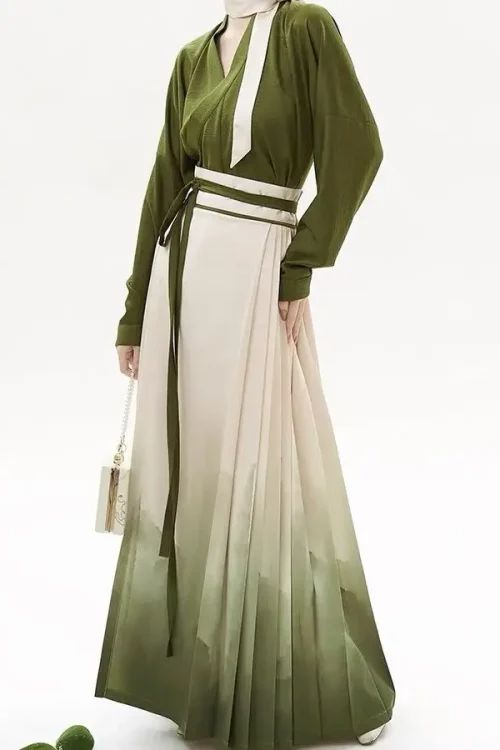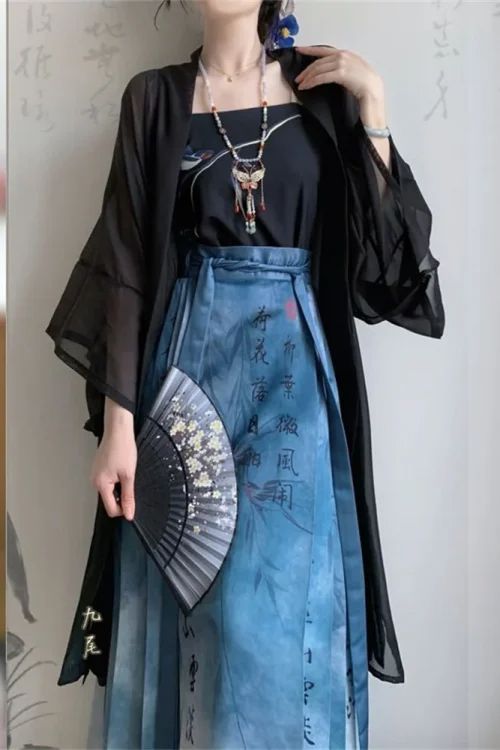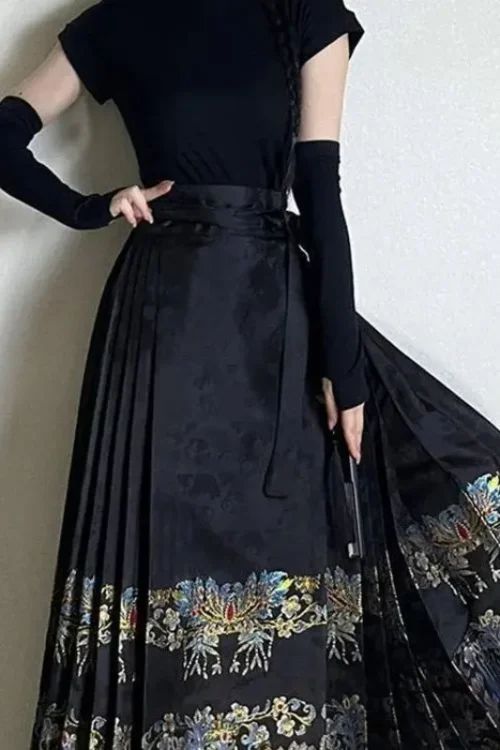马绵群: A Historical Perspective on China’s Horse-Face Skirt
The mamianqun, or “horse-face skirt,” is a traditional Chinese garment that has recently experienced a resurgence in popularity. This distinctive skirt, characterized by its high waist and A-line silhouette, has a rich history dating back centuries.

Historical Significance
During the Ming dynasty (1368-1644), the mamianqun was a staple of women’s wardrobes, particularly among the upper classes. Its elegant lines and flowing fabric exuded both beauty and status. However, with the rise of the Qing dynasty (1644-1912), the mamianqun fell out of favor, replaced by the more restrictive qipao.
Contemporary Revival
In recent years, there has been a growing interest in reviving traditional Chinese fashion, and the mamianqun has emerged as a symbol of this trend. Contemporary designers have reinterpreted the classic silhouette, incorporating modern fabrics and embellishments while preserving its essential features.
Cultural Heritage and Empowerment
The revival of the mamianqun has been driven by a desire to reconnect with China’s cultural heritage. It represents a celebration of traditional aesthetics and a rejection of Western fashion norms. Moreover, the skirt’s versatility has made it appealing to a wide range of women, from fashion enthusiasts to those seeking a unique and stylish way to express their Chinese identity.
The mamianqun has also gained popularity as a symbol of female empowerment. Its high waist and A-line shape create a flattering and confident silhouette, empowering women to embrace their bodies and assert their individuality.
Impact on the Textile Industry
Furthermore, the revival of the mamianqun has had a positive impact on the Chinese textile industry. The demand for traditional fabrics and craftsmanship has led to a resurgence in these skills, supporting local artisans and preserving cultural heritage.
结论
In conclusion, the revival of the mamianqun is a testament to the enduring appeal of traditional Chinese fashion. It represents a celebration of cultural identity, female empowerment, and the preservation of artisanal skills. As the mamianqun continues to gain popularity, it is likely to remain a symbol of China’s rich cultural heritage and its vibrant fashion scene.
The Revival of Mamianqun: Modern Interpretations of a Traditional Garment
Mamianqun, the horse-face skirt, is a traditional Chinese garment that has recently experienced a resurgence in popularity. This iconic piece, characterized by its distinctive trapezoidal shape and intricate embroidery, has captivated fashion enthusiasts and cultural preservationists alike.

Origins and Evolution
The origins of mamianqun can be traced back to the Ming dynasty (1368-1644), where it was worn by women of all social classes. Its unique design, with a wide waistband and a flared hem, allowed for freedom of movement and showcased the wearer’s figure. The skirt’s name, “horse-face,” is derived from its resemblance to the elongated face of a horse.
Over the centuries, mamianqun evolved in style and ornamentation. During the Qing dynasty (1644-1912), it became more elaborate, featuring intricate embroidery and embellishments. The skirt’s popularity waned in the early 20th century due to Western influences and changing fashion trends.
Modern Interpretations
However, in recent years, there has been a renewed interest in mamianqun as a symbol of Chinese cultural heritage. Contemporary designers have reinterpreted the traditional garment, incorporating modern elements while preserving its essence. These modern interpretations range from casual skirts suitable for everyday wear to haute couture pieces that showcase the skill and artistry of Chinese craftsmanship.
Cultural Preservation
The revival of mamianqun has been driven by a desire to connect with China’s rich cultural past and to celebrate the beauty and diversity of traditional Chinese clothing. It has also been influenced by the growing global appreciation for ethnic and cultural fashion.
The resurgence of mamianqun has not only revived a traditional garment but has also sparked a broader conversation about the importance of cultural preservation and the role of fashion in shaping cultural identity. As China continues to embrace its cultural heritage, mamianqun is poised to remain a symbol of both tradition and modernity, connecting the past with the present and inspiring future generations.
Mamianqun in Contemporary Fashion: Embracing Cultural Heritage in Style
Mamianqun, the traditional horse-face skirt of China, is experiencing a remarkable revival in contemporary fashion. This iconic garment, characterized by its distinctive trapezoidal shape and intricate embroidery, is gaining popularity as a symbol of cultural heritage and a source of inspiration for modern designers.

Historical Roots
The origins of mamianqun can be traced back to the Ming Dynasty (1368-1644), where it was worn by women of all social classes. The skirt’s unique shape, resembling a horse’s face, was believed to bring good fortune and ward off evil spirits. Over time, mamianqun became an integral part of Chinese folk culture, particularly in rural areas.
Modern Resurgence
In recent years, there has been a growing interest in reviving traditional Chinese garments, including mamianqun. This resurgence is driven by a desire to preserve cultural heritage and promote national identity. Designers are incorporating elements of mamianqun into their collections, creating contemporary pieces that blend tradition with modernity.
Versatility and Style
One of the key factors contributing to the revival of mamianqun is its versatility. The skirt’s simple yet elegant design allows it to be paired with a wide range of tops and accessories. It can be dressed up for formal occasions or dressed down for casual wear. This adaptability makes mamianqun a practical and stylish choice for women of all ages.
Artistry in Embroidery
Moreover, the intricate embroidery on mamianqun is a testament to the skill and artistry of Chinese artisans. The patterns and motifs used in the embroidery often carry symbolic meanings, such as flowers representing prosperity and birds representing freedom. By incorporating these traditional elements into their designs, contemporary designers are paying homage to the rich cultural heritage of China.
结论
The revival of mamianqun is not only a fashion trend but also a reflection of a broader cultural shift. As China’s economy and global influence continue to grow, there is a renewed appreciation for traditional values and cultural identity. Mamianqun, as a symbol of this heritage, is playing a significant role in shaping the country’s contemporary fashion landscape.
